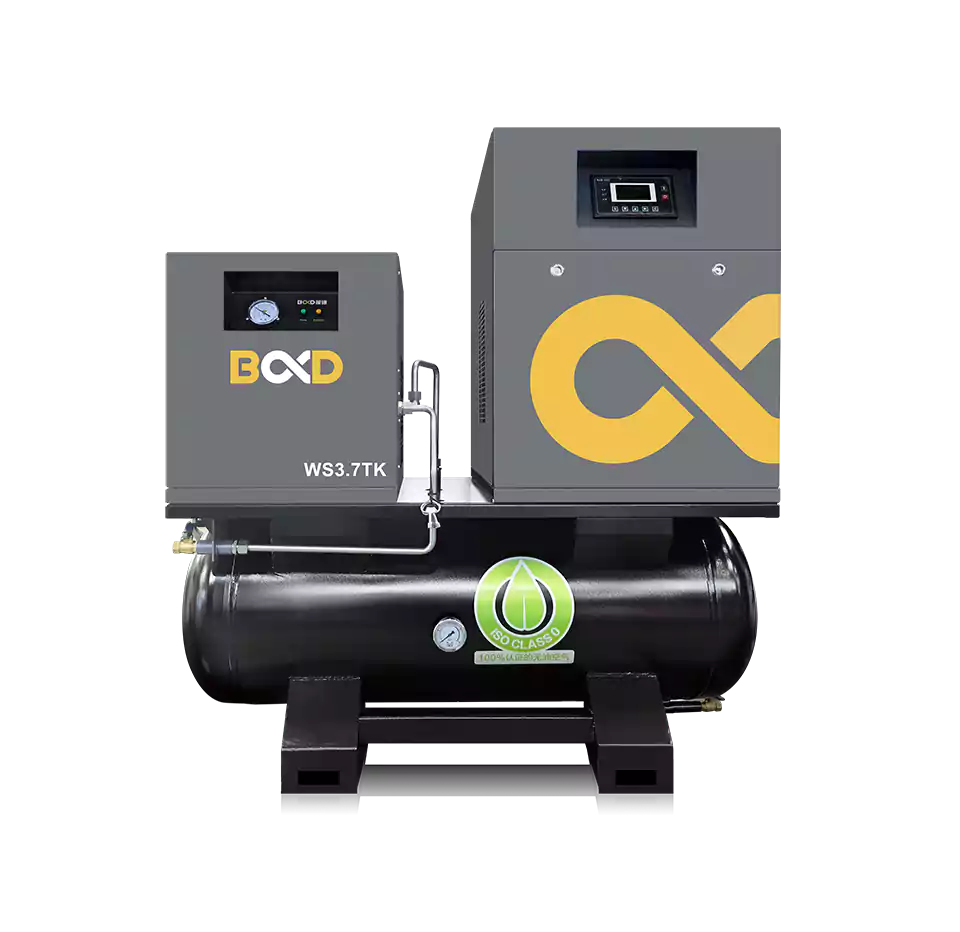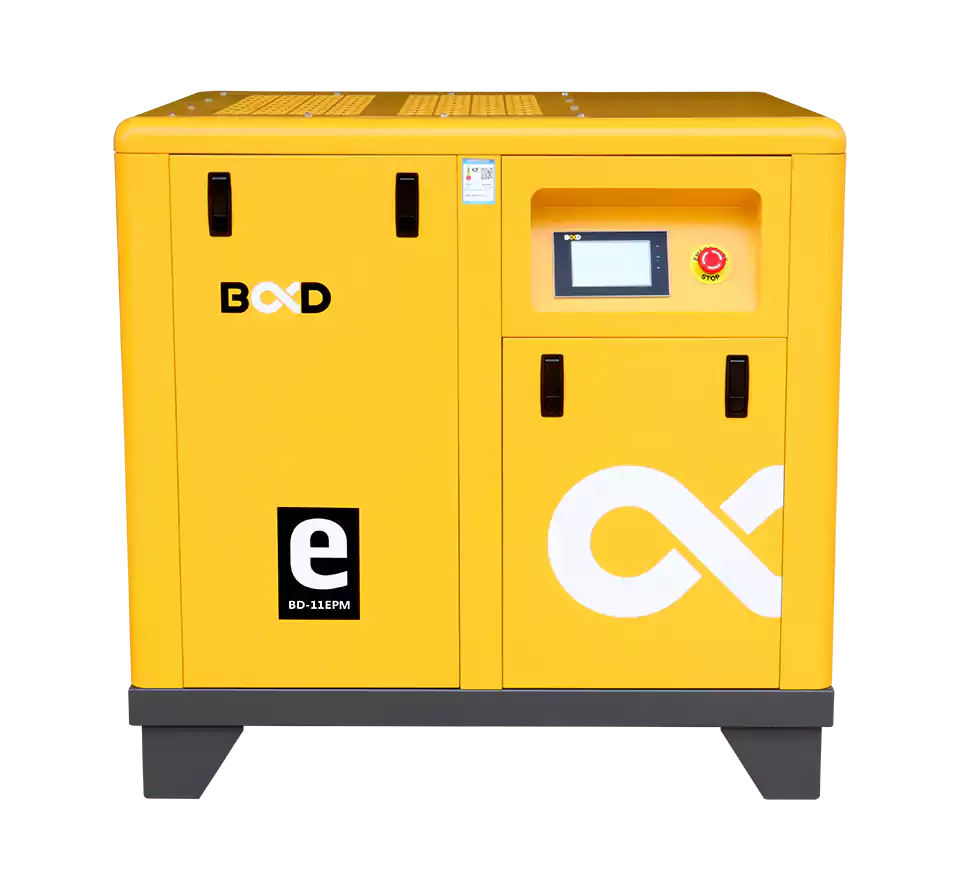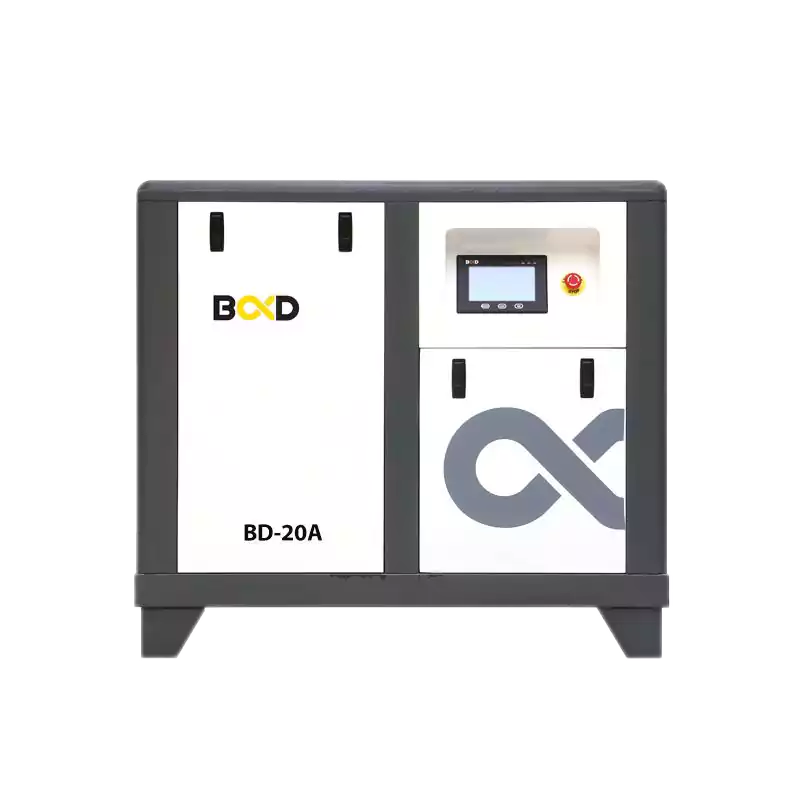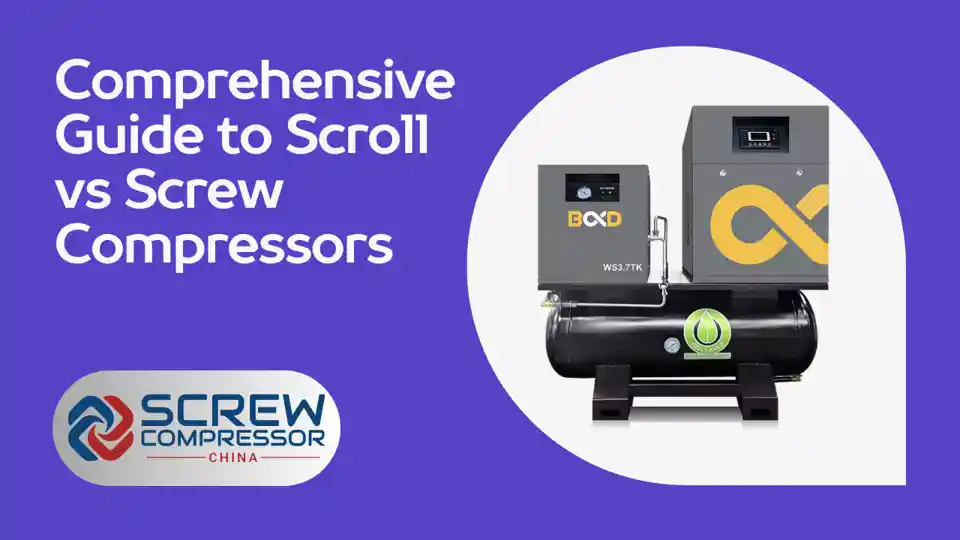Understanding the differences between scroll and screw compressors is essential for choosing the right air compressor for various applications—from residential to heavy-duty industrial use.
Scroll vs Screw: Basic Differences
What is a Scroll Compressor?
Scroll compressors, featuring a design ideated back in 1905, utilize two interleaving spiral-shaped scrolls to compress air. One scroll remains stationary while the other orbits around it, progressively reducing the volume of air pockets and compressing the air.
These compressors are known for their high efficiency and smooth operation, which makes them ideal for air conditioning, refrigeration, and specific industrial applications due to their quiet performance and compact design.

Scroll compressors operate by trapping air between two interleaving scrolls, one fixed and one orbiting. As the orbiting scroll moves, it reduces the volume of the trapped air pockets, compressing the air continuously.
This continuous compression process results in high efficiency, low noise, and minimal vibration compared to other compressor types.
The key advantages of scroll compressors include:
- High efficiency, often over 90%, due to continuous compression without pulsation
- Quiet operation thanks to fewer moving parts and smooth compression
- Compact and lightweight design, allowing for easy installation in tight spaces
- Low maintenance requirements due to simpler construction and reduced wear
However, scroll compressors also have some limitations:
- Limited capacity range, more suitable for low to medium air volume applications
- Sensitivity to contaminants like dirt and moisture, requiring proper filtration
- Higher initial cost compared to some other compressor types
Despite these drawbacks, scroll compressors remain a top choice for many residential, commercial, and light industrial applications where reliability, efficiency, and low noise are priorities.
What is a Screw Compressor?
Invented in 1878, screw compressors consist of two helical rotors—male and female—that mesh closely without touching. As these rotors rotate, they compress the air between them.
Screw compressors are appreciated for their durability and ability to handle large volumes of air, making them suitable for various applications, including those requiring oil-free air.

Screw compressors operate by drawing air into the space between two intermeshing helical rotors. As the rotors turn, the volume of the air trapped between them decreases, compressing the air. The compressed air is then discharged through the outlet.
The main advantages of screw compressors include:
- High durability and long service life, often outlasting other compressor types
- Ability to handle large air volumes and operate continuously without overheating
- Wide capacity range, suitable for various industrial applications
- Relatively simple maintenance compared to some other compressor types
However, screw compressors also have some disadvantages:
- Higher noise levels due to the intermeshing rotors and continuous operation
- More complex design than scroll compressors, potentially leading to higher costs
- Oil-injected models require regular oil changes and may introduce oil into the compressed air
- Larger size and weight compared to scroll compressors
Despite these drawbacks, screw compressors are a popular choice for many industrial applications that require reliable, high-volume compressed air delivery. They are particularly well-suited for continuous operation and can handle demanding environments.
Working Mechanisms Explained
How Scroll Compressors Operate
The mechanism of a scroll compressor involves the intake of air through the open pockets between the scrolls. As the orbiting scroll moves, it decreases the volume of these pockets, compressing the air, which is then discharged through the central port.
This method provides continuous and efficient compression, ideal for medium-sized applications.

The working mechanism of a scroll compressor can be broken down into the following steps:
- Suction: Air enters the open pockets between the fixed and orbiting scrolls at the outer edge.
- Compression: As the orbiting scroll moves, the volume of the air pockets decreases, compressing the air.
- Discharge: The compressed air reaches the center of the scrolls and is discharged through the outlet port.
This continuous compression process occurs with minimal pulsation, resulting in smooth, efficient operation. The scrolls maintain a constant contact seal, minimizing leakage and maximizing efficiency.
The unique advantages of the scroll compressor’s working mechanism include:
- Smooth, continuous compression without the pulsation found in reciprocating compressors
- High volumetric efficiency due to the constant contact seal between the scrolls
- Low noise and vibration thanks to the smooth, continuous compression process
- Fewer moving parts compared to other compressor types, leading to increased reliability
However, the scroll compressor’s working mechanism also has some limitations:
- Limited capacity range due to the fixed size of the scrolls
- Potential for overheating if operated outside of the designed pressure ratio range
- Sensitivity to liquid slugging, which can cause damage to the scrolls
Despite these limitations, the scroll compressor’s working mechanism is well-suited for many applications that require smooth, efficient, and quiet compressed air delivery.
How Screw Compressors Function
Screw compressors work by drawing air in through the inlet, which then gets trapped between the rotating helical screws and is compressed as the volume decreases. The compressed air is then expelled through the discharge port.
This type of compressor is often chosen for applications requiring continuous operation due to its capability to operate 24/7 without overheating.

The working mechanism of a screw compressor can be summarized as follows:
- Suction: Air enters the compressor through the inlet port and fills the space between the male and female rotors.
- Compression: As the rotors turn, the volume of the air trapped between them decreases, compressing the air.
- Discharge: The compressed air is pushed to the outlet port and discharged from the compressor.
This rotary compression process allows screw compressors to operate continuously without the need for valves, making them suitable for demanding industrial applications.
The key advantages of the screw compressor’s working mechanism include:
- Ability to handle large air volumes and operate continuously without overheating
- High reliability due to the simple rotary design with few moving parts
- Wide capacity range, with the ability to adjust output by changing rotor speed or size
- Relatively low maintenance requirements compared to some other compressor types
However, the screw compressor’s working mechanism also has some drawbacks:
- Higher noise levels due to the intermeshing rotors and continuous operation
- Potential for oil contamination in the compressed air with oil-injected models
- More complex design than scroll compressors, potentially leading to higher costs
- Larger size and weight compared to scroll compressors
Despite these limitations, the screw compressor’s working mechanism is well-suited for many industrial applications that require reliable, high-volume compressed air delivery in demanding environments.
Structural and Functional Differences
Design and Maintenance
Scroll compressors are compact and have fewer moving parts, which translates to lower maintenance needs and quieter operation. Conversely, screw compressors, with their more complex design, typically require more frequent maintenance, especially models that utilize oil-injection systems for lubrication, sealing, and cooling.

The design of scroll compressors is relatively simple, with two main components: the fixed scroll and the orbiting scroll. The scrolls are mounted in a compact housing, with the motor and other components located below. This simple design results in several advantages:
- Fewer moving parts, leading to increased reliability and reduced maintenance requirements
- Compact size, allowing for easy installation in tight spaces
- Quiet operation due to the smooth, continuous compression process
- Lightweight construction, making them easier to handle and install
However, the simple design of scroll compressors also has some limitations:
- Limited capacity range due to the fixed size of the scrolls
- Sensitivity to contaminants like dirt and moisture, requiring proper filtration
- Potential for overheating if operated outside of the designed pressure ratio range
In contrast, screw compressors have a more complex design, with two intermeshing helical rotors housed in a larger casing. Oil-injected models also include an oil separation system and additional components for lubrication and cooling.

The more complex design of screw compressors results in some advantages:
- Ability to handle large air volumes and operate continuously without overheating
- Wide capacity range, with the ability to adjust output by changing rotor speed or size
- Durable construction, with robust components designed for demanding industrial environments
However, the complex design of screw compressors also has some drawbacks:
- More frequent maintenance requirements, especially for oil-injected models
- Larger size and weight compared to scroll compressors
- Higher noise levels due to the intermeshing rotors and continuous operation
When it comes to maintenance, scroll compressors generally require less frequent servicing than screw compressors. The simple design and fewer moving parts of scroll compressors result in reduced wear and tear, leading to longer service intervals.
Screw compressors, on the other hand, typically require more frequent maintenance, especially oil-injected models. The oil separation system, filters, and other components need regular servicing to ensure optimal performance and prevent breakdowns. The intermeshing rotors and bearings also experience more wear and may require replacement over time.
In summary, the design and maintenance requirements of scroll and screw compressors differ significantly. Scroll compressors offer a simpler, more compact design with fewer maintenance needs, while screw compressors provide a more robust, high-capacity solution but require more frequent servicing.
Performance and Suitability
Scroll compressors are preferred for quieter environments such as medical facilities or residential areas due to their lower noise levels. They are also suited for applications that don’t demand large volumes of air.
On the other hand, screw compressors are ideal for industrial settings and high-demand environments due to their robust performance and capacity to handle significant volumes of compressed air.

Scroll compressors are known for their high efficiency, low noise, and smooth operation. These characteristics make them well-suited for applications that require a reliable, quiet source of compressed air, such as:
- Medical and dental facilities
- Laboratories and clean rooms
- Food and beverage processing
- Textile manufacturing
- Residential and light commercial air conditioning
Scroll compressors typically offer capacities ranging from 1 to 30 horsepower (HP), with air delivery rates up to 120 cubic feet per minute (CFM). They can operate at pressures up to 145 pounds per square inch (PSI), making them suitable for most light to medium-duty applications.
However, scroll compressors may not be the best choice for applications that require very high air volumes or continuous operation in demanding environments. They are also less suitable for applications that involve high levels of contaminants, as the scrolls are sensitive to dirt and moisture.

Screw compressors, on the other hand, are designed for heavy-duty industrial applications that require high air volumes and continuous operation. They are commonly used in:
- Manufacturing plants
- Automotive and aerospace industries
- Oil and gas processing
- Mining and construction
- Power generation
Screw compressors are available in a wide range of capacities, from 5 to 500 HP, with air delivery rates up to 2,500 CFM. They can operate at pressures up to 350 PSI, making them suitable for the most demanding industrial applications.
The robust construction and ability to handle high air volumes make screw compressors ideal for continuous operation in challenging environments. They are also less sensitive to contaminants than scroll compressors, thanks to their oil-injected design and filtration systems.
However, screw compressors are generally louder than scroll compressors and may not be suitable for noise-sensitive environments. They also require more frequent maintenance, especially oil-injected models, which can lead to higher operating costs over time.
In summary, scroll compressors are best suited for light to medium-duty applications that require quiet, efficient operation, while screw compressors are ideal for heavy-duty industrial applications that demand high air volumes and continuous operation in challenging environments.
Frequently Asked Questions
Q: What are the primary applications of scroll compressors?
A: Scroll compressors are mainly used in air conditioning systems, smaller refrigeration units, and applications requiring low noise levels.
Q: Can screw compressors be used for oil-free applications?
A: Yes, oil-free designs of screw compressors are available, making them suitable for industries like electronics and pharmaceuticals where air purity is crucial.
Q: What is the main advantage of screw compressors over scroll compressors?
A: Screw compressors are more durable and capable of handling larger volumes of air, making them suitable for continuous and heavy-duty applications.
Q: How do scroll and screw compressors differ in terms of noise levels?
A: Scroll compressors generally produce less noise compared to screw compressors, making them a better choice for noise-sensitive environments like medical facilities or residential areas.
Q: What are the maintenance requirements for scroll and screw compressors?
A: Scroll compressors typically require less frequent maintenance than screw compressors due to their simpler design and fewer moving parts. Screw compressors, especially oil-injected models, need more regular servicing to ensure optimal performance.
Conclusion
Choosing between a scroll and screw compressor depends on the specific application requirements, such as air volume, operating environment, noise level, and maintenance needs. Scroll compressors are best suited for light to medium-duty applications that prioritize quiet operation and energy efficiency, while screw compressors excel in heavy-duty industrial settings that demand high air volumes and continuous operation.
By understanding the key differences between these two types of compressors, businesses can make informed decisions when selecting the most appropriate compressed air solution for their needs. Consulting with experienced compressed air professionals can further help in identifying the optimal compressor type and configuration to maximize performance, reliability, and cost-effectiveness.
